Zulu warriors, 1882. Image extracted from page 279 of “A Holiday in South Africa … With map and illustrations”, by LEYLAND, Ralph Watts. Original held and digitized by the British Library.
Deep within the heart of Africa, the Zulu nation stands as a testament to the indomitable spirit of a people who carved an empire with their resilience, strategic prowess, and unparalleled warrior culture. Over the centuries, the story of the Zulu has become inextricably entwined with tales of heroism, strategic brilliance, and an enduring legacy that transcends the annals of warfare.
The rise of the Zulu nation began in the early 19th century under the leadership of King Shaka Zulu. Born in 1787, Shaka transformed the Zulu from a small clan into a formidable kingdom by centralizing power, innovating military tactics, and expanding territories. His strategies not only ensured political dominance but also instilled a sense of pride and unity among the tribe.
The Zulu warriors, renowned for their bravery, discipline, and battlefield prowess, left an indelible mark on African history. Their rise to prominence began in the early 19th century under the visionary leadership of King Shaka Zulu. Born in 1787, Shaka transformed the Zulu from a small clan into a formidable kingdom by centralizing power, innovating military tactics, and expanding territories.
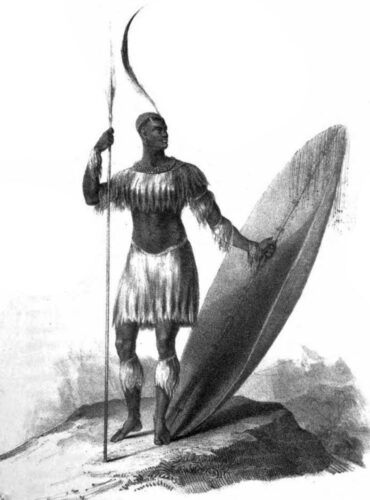
The heartland of the Zulu kingdom is located in what is today known as the KwaZulu-Natal province of South Africa. This region is defined not only by its political boundaries but also by its diverse landscapes, which played a significant role in the development and sustenance of the people. The Drakensberg Mountains, which form a natural barrier with the Kingdom of Lesotho to the west, are a notable feature. These mountains played a strategic role during times of conflict, serving as a natural defense against invasions.
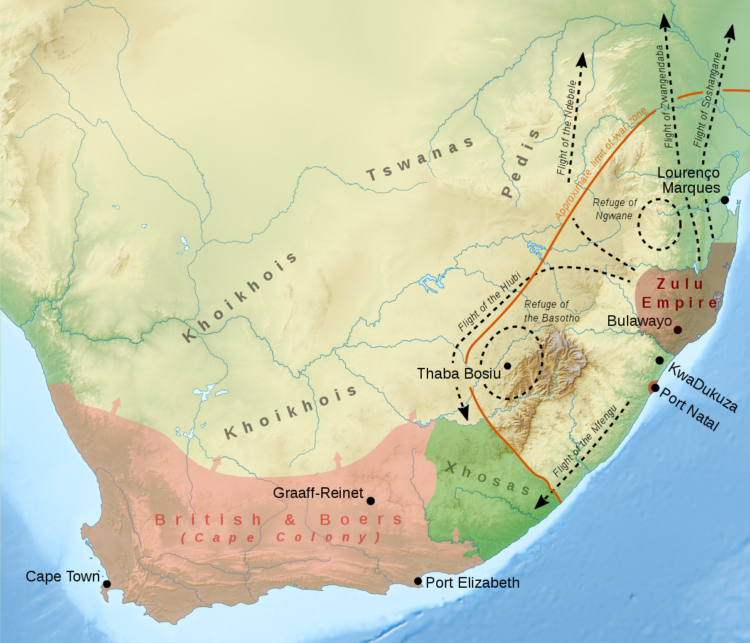
Organization and Structure
The Zulu army operated profoundly differently from its professional British counterpart. Rather than a standing army, the Zulu forces were part-time citizen militias. The heart of their system lay in guilds known as “amabutho” (singular: “ibutho”). These guilds served as a means of central control over the most productive segment of the Zulu population — its young men.
Before the emergence of the Zulu kingdom, each chiefdom raised its own amabutho. Every two or three years, young men who had reached their late teens since the previous call-up were gathered at the royal homestead and formed into a unit. They were given regimental names, specific ceremonial uniforms of feathers and furs, and older men were appointed as officers over them. These units served as the chiefdom’s labor force, police, hunting parties, and army.
Although housed in special settlements during assembly, there was no infrastructure to support them for extended periods, and they would disperse and return home after completing their tasks. Even in 1879, the Zulu army was seldom mobilized for more than two or three weeks at a time.
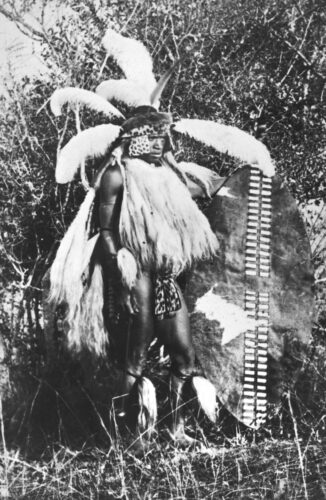
Marriage and Service
The common age of ibutho members fostered a strong sense of belonging, and the obligation to serve extended into old age. However, the burden fell more heavily on younger, unmarried men. Marriage was a significant rite of passage within Zulu society, marking the point at which a man left his father’s homestead to establish his own. The Zulu kings dictated when ibutho members were allowed to marry, often delaying permission until their mid-30s to maximize the period of direct service. Once married, Zulu men bound a ring of fiber and gum in their hair, signifying their shift in status.
Military Ethic and Equipment
The Zulu warriors were fiercely proud of their honors and distinctions. Their military ethic emphasized loyalty, discipline, and a strong sense of belonging. The king supplied cattle from the royal herds, matched by the color of their hides, from which uniformed war shields were made. Each warrior provided his own striking weapons. The long-bladed, thick-hafted stabbing spear was,a favorite. By 1879, many warriors had also acquired obsolete firearms imported into the country by white traders. These firearms coexisted with traditional weaponry, reflecting the Zulu warriors’ adaptability and resourcefulness.
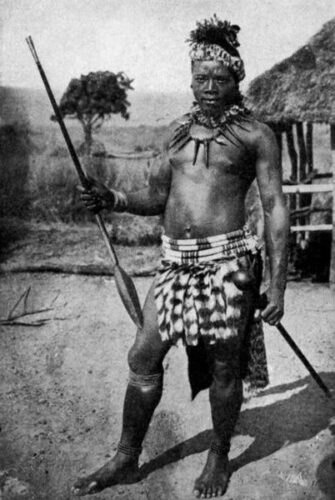
Tactics
Shaka played a pivotal role in shaping the Zulu warriors’ military tactics. His influence reverberated through their approach to warfare. Shaka centralized power within the Zulu kingdom, unifying previously fragmented clans. He reorganized the Zulu army, creating a more efficient and disciplined force.
The Zulu warriors employed distinctive military tactics that set them apart from other African tribes. The preferred tactic of the Zulus was the “Buffalo Horn” formation. In battle, they attempted to encircle the enemy using flanking maneuvers. This formation allowed the Zulu warriors to envelop their opponents, attacking from both sides like the curved horns of a buffalo. By surrounding the enemy, they maximized their chances of overwhelming and disorienting their foes.
The Zulus were well aware of the advanced rifle weaponry used by the British forces. Consequently, their tactics revolved around using their spears in close quarters fighting They relied on their agility, speed, and skill with traditional weapons to engage the enemy at close range.
Unlike professional armies, the Zulu warriors did not undergo formal tactical training. However, they could perform essential movements based on their experience with large animal hunts. Their skirmishing skills were extremely good, and they demonstrated unwavering determination even under heavy fire.
The Zulu military operations were controlled by senior Zulus, often observing from a remote vantage point. If an assault faltered, a senior warrior could be dispatched into battle to rally or lead the troops. This decentralized command structure allowed for flexibility and adaptability on the battlefield.
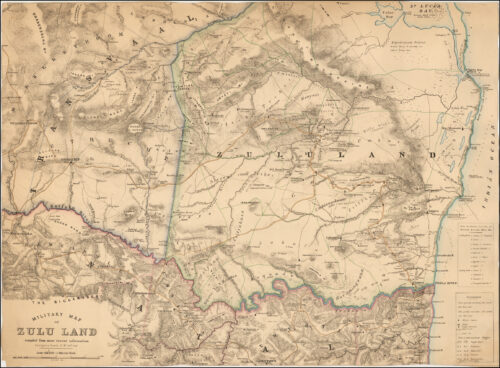
European Response
European forces faced the formidable Zulu warriors with a mix of awe, respect, and strategic adjustments. European soldiers admired the Zulus’ courage and fierce determination in battle. Witnessing the rhythmic chants, precise formations, and relentless charges struck terror into their ranks. European forces sought to exploit their technological advantages.
European forces relied heavily on firepower. Their advanced rifles allowed them to engage from a distance. They formed defensive squares or “laagers” (wagon circles) to protect against Zulu attacks. The British used their Martini-Henry rifles effectively, but the Zulus’ speed and agility still posed challenges.
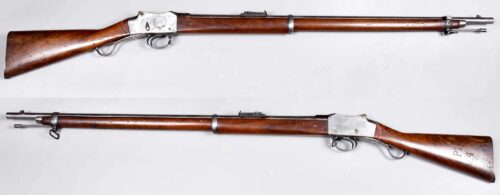
European diaries from the 19th century often allude to the imposing sight of Zulu impi (warrior units) on the march. The Zulu war cry and their fierce determination created a psychological impact. European commanders grappled with maintaining morale in the face of such formidable opponents.
European officers studied Zulu tactics and adapted their own strategies. They learned to avoid direct confrontation in open terrain and focused on using their firepower effectively. The Zulu tactics transcended their time, leaving an indelible imprint on the annals of warfare and inspiring generations of warriors.
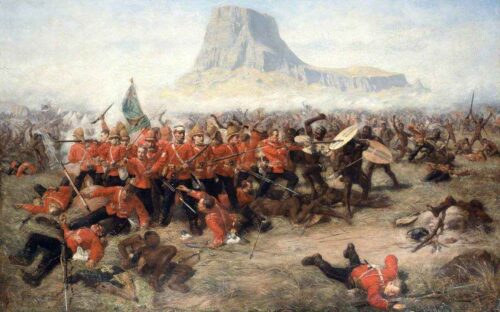
Shaka’s Later Years
However, Shaka’s later years were marked by increasing cruelty and erratic behavior. Historians believe the assassination of his mother in 1827 may have profoundly affected his mental health. He became more tyrannical, instituting policies that led to widespread suffering. One of the most infamous decrees after his mother’s death was the ban on planting crops and the killing of cows, ensuring that no milk would be available. This led to a famine, further complicating matters for his subjects.
In 1828, amid rising internal tensions and unrest, Shaka Zulu met a tragic fate. Seen as a growing threat by his own people, he was assassinated by his half-brothers Dingane and Mhlangana. Dingane then succeeded Shaka as the leader of the Zulu Kingdom. While Shaka’s reign was marked by both expansion and innovation, it was also a time of intense violence and social disruption. Nevertheless, his legacy as a military genius and the founder of the Zulu Empire remains intact.
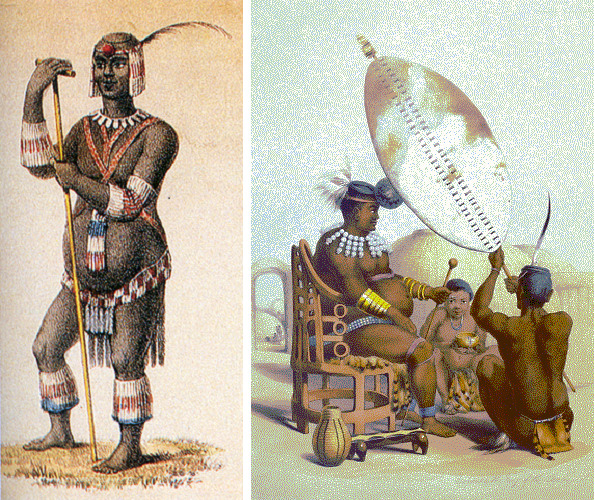
Legacy and Impact
The Zulu warriors’ brief but turbulent reign saw them clash with the British Empire near the height of its power. The 1879 war, known as the Anglo-Zulu War, began with a great Zulu victory but ultimately ended in defeat. Despite this, their legacy endures as a tribute to their courage, military skill, and cultural resilience. The Zulu warriors remain a symbol of Africa’s fearsome battle-bred heritage.
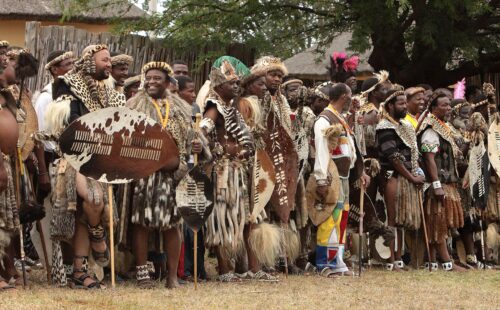
The Zulu warriors exemplified a unique blend of tradition, discipline, and adaptability. Their impact on history reverberates through the ages, reminding us of the indomitable spirit of those who defended their land and culture with unwavering determination.
In modern South Africa, Shaka Zulu remains a symbol of courage, resilience, and the unyielding pursuit of greatness. His influence extends beyond borders, contributing to the strengthening of African identity and pride.

